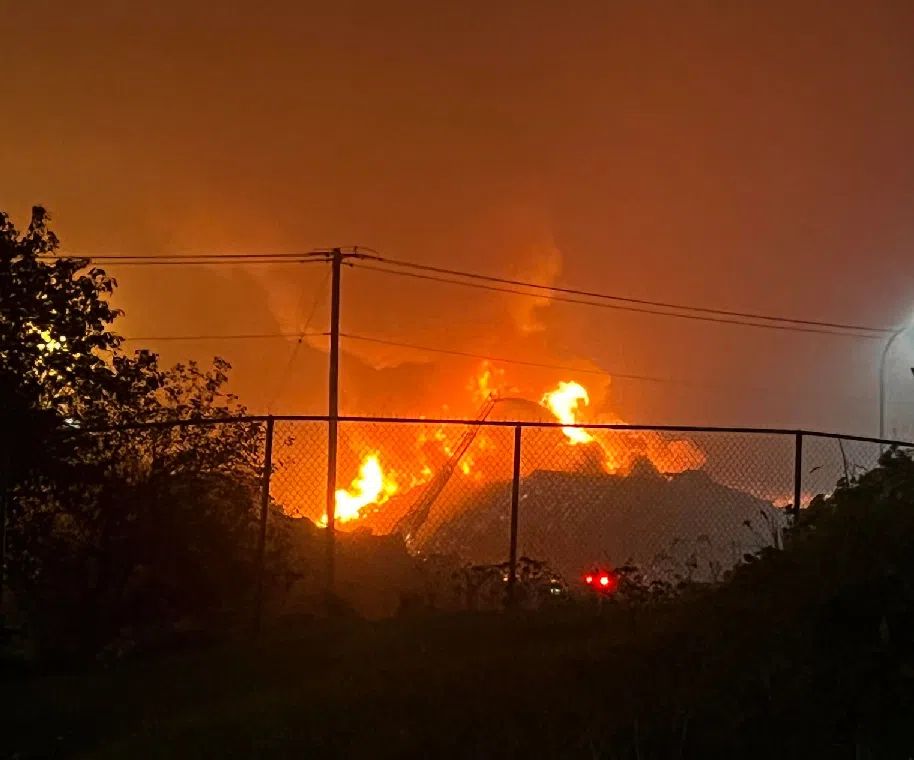A long-awaited report into September’s fire at a Saint John scrapyard says the facility should not be in the centre of the city.
But a provincially-appointed task force stopped short of recommending that American Iron & Metal (AIM) be relocated or shuttered for good.
Attorney General Ted Flemming said it will be up to the appropriate regulators to determine the future of the facility.
“The expectation is that these parties will act expeditiously and take the decisions and actions within their respective mandates to address the risks and hazards,” Flemming told reporters on Tuesday.
The task force, which has been meeting for the past two months, made a total of 12 findings following the Sept. 14 fire.
The blaze inside a massive pile of crushed cars burned for more than 40 hours, prompting a voluntary city-wide shelter-in-place order due to air quality concerns.
It also renewed calls from some in the community, including members of Saint John council, to shut down AIM Recycling once and for all.
Flemming said a 2010 environmental impact assessment (EIA) submitted by AIM to operate an industrial metal shredder did not address items such as fires, explosions, and the potential release of contaminants.
“There was no mention of the risk of fire or explosions,” he said. “However, since 2011, there have been at least 181 explosions and 22 fires.”
Flemming said the scrap metal piles exceeded the size recommended in the EIA and prescribed by the National Fire Code by as much as 2.5 times.
He also noted that the company did not and does not have an emergency plan capable of effectively responding to a fire like the one that happened in September.
The report also found that the Saint John Fire Department is not equipped to respond to a fire of this magnitude, and the city’s water resources are not sufficient.
“This is in no way a criticism of the Saint John Fire Department, but it speaks to the enormity of the fire,” said Flemming.
The Lancaster Reservoir on the city’s west side was drained of almost half its capacity within the first six hours and could not have been maintained for more than an additional six hours.
Flemming said had the Atlantic Osprey vessel not been in port and able to assist, the situation could have been much different.
“Without the firefighting assistance from the Irving Osprey vessel, this already extremely dangerous event could have manifested itself to a horrendous catastrophe,” he said, noting the fire could have burned for up to a week.
While the cause of the fire has not been determined, investigators believe the probable ignition source was a failure of discarded rechargeable batteries.
The task force also found a “material risk” that a similar catastrophic fire could happen again at the AIM operation.
“The location of the AIM operation, in the middle of the Saint John community, adjacent to the harbour and a residential neighbourhood, is entirely inappropriate given its now known hazards and risks,” said the report.
“The AIM operations are an environmental, health and safety risk to Saint John, surrounding communities and their citizens.”
Independent testing conducted by Dillon Consulting found contaminants at the AIM facility “which exceed criteria that may pose a risk to human and ecological health.”
“In addition, it is likely that the smoke generated by the fire carried significant contaminants through the air, which were then deposited where soot or particulate landed.
It said significant additional testing and analysis is needed to assess the existence and scope of the environmental and human health impacts
Flemming said testing done after the fire does not suggest soil quality was affected to the extent that it would be of concern to people’s health.
While one or more levels were higher than expected at four of the 12 sites, he said those are not believed to be related to the fire.
Craig Bell Estabrooks, CEO of Port Saint John, said it is evident that a lot of work went into this report in a short period.
“The port will determine all the appropriate steps to fulfil its mandate under the Canada Marine Act to maintain order and safety in the port,” said Bell Estabrooks.
AIM Recycling did not immediately respond to a request for comment.





